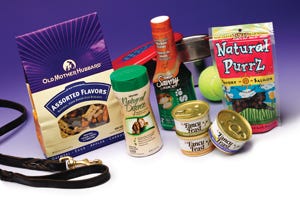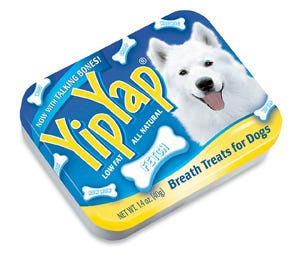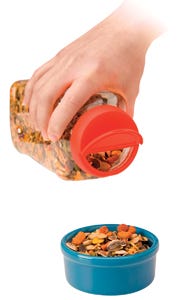A 'paws' for petfood packaging
February 4, 2014
|
Approximately 63 percent of American households own a pet today and the number of households that have a pet leaped from 58.3 million to 71.6 million over the past decade. In 2007, Americans spent about $41 billion on pet products. It's no wonder, then, that people are so devoted to their pets that even if they're allergic to them (between 10 to 19 percent claim to be), they still share their homes with their furry or feathered companions. This is great news for the petfood and petcare market, as indicated by a national pet owners survey conducted by the American Pet Product Manufacturers Association (APPMA) for 2007-2008.
But with opportunity comes competition.
Innovative product and packaging development is the key to taking advantage of the growing pet market. The top two ways that pet owners find new products include browsing the store shelves and television advertisements, according to the APPMA. Packaging not only improves the shopping experience, but can also play a large role in consumer loyalty to a brand. More than 700 new toys, treats and other products were introduced alone in 2006 at the Global Pet Expo, making packaging an even more crucial component in selling products.
Studies indicate that petfood packaging follows many of the same trends as packaging for humans. Brand differentiation, brand enhancement and convenience rate highly with consumers when selecting a brand of food or petcare products.
Top market drivers
There are many major trends influencing the growth in the petfood and petcare segment. This paper addresses 10 forces guiding the market in 2008 and how packagers can utilize packaging to take advantage of these growth areas:
I. The pet as a family member
The family dog, cat or fish is no longer considered to be the family pet. Instead, they are a family member that deserves premium quality care. Nearly 50 percent of all pet owners not only buy birthday or holiday presents for their animals, but also let the dog sleep in their bed. According to a pet survey in 2006 by Mintel, 83 percent of pet owners call themselves mommy or daddy. As humans anthropomorphize their pets, they purchase products and services for their pets that are fun and an extension of their own personal lifestyle.
To stay ahead of the competition, new and established pet brands must convert consumer needs into tangible products that offer convenience and ease-of-use.
People want their pet products to convey a premium quality, and packaging that is inferior to human product standards will fail to deliver the necessary shelf impact to draw in shoppers. The petfood and petcare segment is one of a handful of markets where price sensitivity is very low. Consumers are more interested in the quality, taste and functionality of products, and selecting packaging that communicates this message can make products stand out on the store shelf.
One great example is Iams Savory Sauce, which is a topping equivalent to human foods like ketchup, and is primarily used to enhance the eating experience for the dog. The package conveys the message of quality and taste very clearly in its sauce-style polyethylene terepthalate (PET) container and flip-top dispensing closure. This package makes the product look so appetizing, that it could be mistaken for a human-grade gravy.
II. Women's influence on packaging
Petfood and petcare manufacturers need to cater to the female buyer when selecting packaging to brand products, because women are the buyers of pet products in 8 out of 10 households (says APPMA). Furthermore, women are more likely to own dogs and cats, and their emotional commitment to their pets can transfer easily into spending more money on accessories, treats and toys (Mintel Pet Survey 2006).
Our own research, developed through focus groups conducted over a number of years, indicates that women know exactly what appeals to them. If packaging does not meet their requirements, their buying decisions are clearly influenced.
The study found four areas that influence the packaging preferences of women: packaging color; shape; product image; and text. For instance, if the product shape is not ergonomic or if a package is difficult to lift and carry, it is much more difficult to sell to women. Packages like Purina's Tidy Cat litter and Deli-Cat brand catfood appeal to the female buyer. Both items come in large jug containers that are easy to store in a cupboard and have convenient carrying handles to make their use easier.
III. Convenient treats
Giving a pet a treat is one of the most enjoyable activities a person can do with their pet. Most people give their dogs an average of three treats per day, for anything from training and tricks to the excitement of watching their pet indulge (APPMA). Overall, 90 percent of dogs and just less than 70 percent of all other pets are given treats. The experience of giving a treat must be simple and fun. Convenient packaging that can provide easy access and freshness is more likely to attract and maintain consumers to products.
Moist cat treats are no hassle for the owner. They often come in standup pouches that are resealable, ensuring the product will stay fresh up to the last treat.
Focus group research indicates that a premium-looking package translates into a quality product in the consumers mind. For instance, Chomp's YipYap all-natural treats for dogs come in a tin reminiscent of Altoid's high-end package for its “curiously strong” mints. The success of this product can be greatly attributed to the effort that went into selecting a premium quality package. The takeaway for brand managers of petfood products is that packaging can make or break your products success in the pet treat segment.
IV. Recalls spark interest in “Made in America” products
In March 2007, major petfood manufactures started recalling a variety of petfoods and treats that
|
would eventually affect more than 5,300 petfood products. By the end of March, more than 100 pet deaths and 500 cases of kidney failure were blamed on contaminated pet products. A survey conducted by CMi (now part of NSF Intl., an international food safety and assurance company that operates throughout the food supply chain) in 2006 suggests that 75 percent of Americans are concerned about food safety issues and that they pay close attention to food packaging.
The recalls across both human and pet foods have made consumers increasingly aware of where their petfood is made, because the majority of the problematic food was made outside of the U.S.
Consumers lost trust in brands they had been using for years and are now taking a very careful look at the new products. Many pet consumers will only buy products that are “Made in America,” and if the packaging does not convey this or if the message is too small, then the brand could lose business. One product that has capitalized on this idea is Pet Factory's rawhide products, which contain a simple blue sticky label that's central message is “American Beefhide.” If you have an American-made product, take advantage of marketing this fact on your package in a visible way.
V. Heightened awareness of ingredients
The magnitude of the petfood recalls has encouraged pet owners to educate themselves on what exactly ingredients such as “wheat-gluten” and “meat byproducts” contain. Many consumers are questioning the integrity of brands and are considering a switch to something new. This gives new players an opportunity to differentiate themselves with ingredients that offer healthier alternatives to a usual name-brand food.
Innovative packaging that communicates a message that the ingredients in a petfood are healthy and of human quality can definitely appeal to pet owners. For example, Old Mother Hubbard's oven-baked dog treats are packaged in a bag that looks fresh from the bakery, with text that lists the healthy ingredients of oatmeal, eggs, apples, and carrots on the front of the bag.
VI. Pet organics and nutrition
As people look for healthier lifestyles, they seek the same care for their pets. The trend to more
|
natural and organic foods for humans has already been emulated in the petfood market, with an increase in organic petfood sales of 46 percent in 2005, 36 percent in 2006, and an expected, continued growth of 25 percent throughout 2008, according to the Organic Trade Assn. The number-one drawback to owning a pet for the majority of owners is that eventually it will die. As pets begin to age, their owners are looking for ways to extend their lives and many owners turn to vitamins and supplements. Overall, the pet health product segment is expected to grow 63 percent by 2012, indicates Simmon Market Research.
Consumers are least price-sensitive in this segment, considering that more than one-third claim that money is of no concern when it comes to their pet's health (obtained from a Hartz survey).
Sellers of organic or natural pet products can use packaging to help brands capitalize on this healthy trend. For example, Zuke's “Natural PurrZ” cat treats communicate the [healthy] message in the product name and the treat offers convenience to the pet owner with its resealable, standup pouch. With vitamins, it's important to remember that the human still has to operate the package and ensure product safety. Difficult child-resistant and certain continuous-thread closures can be especially hard for aging adults to use. It is also important for the packaging to communicate in an easy and fun way why organics and pet nutrition are the right products for pets.
Organic cat and dog kits from C&P's Organix, offer a fun and convenient way to introduce organic pet products into the consumer lifestyle. The kit offers a variety of organic pet foods and treats that come in a neatly packed storage container with a handle for carrying.
VII. Filling an empty nest
The “Baby Boomer” generation has been a major market driver for everything from houses to cars to entertainment to almost all consumer products for several decades.
Generally defined as those born between the years 1946 and 1964, the very first of these “Baby Boomers” are turning 60 this year. Many are suffering from the empty nest syndrome that comes with watching kids go to college, start a career, and/or get married. The pet, any size or species, is the new surrogate child to keep them company and make them laugh. Many boomers claim that owning a pet helps them stay healthier and makes the transition of growing into adults easier.
Baby Boomers place a significantly higher monetary value on convenient packaging, compared to other generations. If pet products aren't easy to use, then they won't have a chance at converting this demographic. One typical market misconception is that Boomers are at a point where they are brand loyal and reluctant to change. Surveys indicate differently. A study by the American Assn. of Retired People (AARP, 2002) indicated that consumers 45 and older are as likely to change brands as younger consumers. For added convenience and an easier-opening package, assuming quality is equal, the Boomer generation would have little or no issue in making a brand change and would likely even consider paying more for that brand.
Purina's Fancy Feast canned variety pack is an excellent example of packaging convenience that appeals to Baby Boomers. The cans come in a paperboard case with a handle for carrying and a dispensing chute that opens for easy access with just the tear of a strip. Additionally, the can itself has a pull-tab that eliminates the need for utensils and makes serving a gourmet meal simple and clean.
VIII. Cleaning up the mess
One major disadvantage of owning a pet can be the mess and smell the beloved creature can leave in its trail. As a result, petfood and petcare manufactures have launched a variety of innovative cleaning products that remove stains and odors. We all know that our pets tend to be repeat offenders when it comes to accidents, so these innovative products come in a variety of stockkeeping units to cater to a pet owners every need, whether it be wipes, sprays or detergents.
Getting rid of fleas and ticks is another issue. Sergeant's Sentry Natural Defense, which protects against fleas and ticks, is a good example of eye-catching packaging that comes in a variety of options.
One of its most innovative offerings comes in an ergonomically shaped high-density polyethylene bottle topped with a dispensing cap. The bottle design helps this package stand out against the growing number of petcare products on the store shelf and the closure builds brand loyalty once the consumer experiences the ease of dispensing at home.
Pet owners also have seen a growing number of luxury pet-cleaning products in high-end department stores, such as Kiehl's dog cleansing spritz. This product comes in an upscale, cosmetic-looking PET bottle and can be found at Nordstrom and Saks Fifth Avenue stores. The products that will be most successful in the “cleaning up the mess” market will be those that not only offer an innovative product, but a user-friendly package.
IX. Eco-friendly pet products
The environment is a growing concern among many people, and a lifestyle change for us will very likely translate into a lifestyle change for our pets. With sustainability and the awareness of the diminishing supply of natural resources, manufacturers should “think green” when creating products and packaging. If selling an eco-friendly product, make the packaging eco-friendly as well. Several eco-friendly kitty litters out there don't utilize environmentally friendly packaging. Cat litter is also heavy, and many of the eco-friendly brands don't yet offer a handle to make carrying them easier. Items, such as pet beds made from plastic bottles and recycled-mateiral dog toys can both benefit from more eco-friendly packaging.
X. Emerging pet markets
Eastern Europe, Latin America and South Asia are seeing growth in the market for petfood and petcare products. As they gradually improve their standard of living, consumers will have a rising disposable income, part of which is likely being spent on care for their new pet companions. Knowing what types of packaging delivers convenience in their terms will help build brand loyalty in the pet market.
This white paper was produced courtesy of Weatherchem Corp.,www.weatherchem.com.
About the Author(s)
You May Also Like





